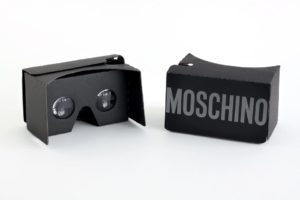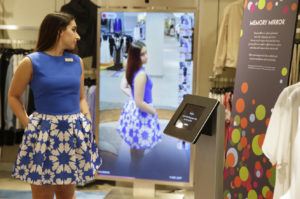Manus X Machina: Saks Fifth Avenue in an Age of Technology

Saks Fifth Avenue was founded in 1924[1] and has since been a mainstay in the American retail landscape. Saks caters to the luxury customer and operates under the traditional department store model, offering a range of consumer products including clothing, shoes, cosmetics and homewares. However, as the retail landscape has shifted away from brick & mortar and into e-commerce, the retail giant has been forced to adapt and rethink its operating model. Nonetheless, Saks has embraced the digital trend and is championing a number of innovations to improve its merchandising, marketing, distribution and customer experience:
Merchandising: In 2012, Saks began placing Electronic Product Code (EPC) / Radio Frequency Identification (RFID) technology on most of its merchandise.[2] The EPC/RFID technology has been pivotal in revolutionizing Saks’ inventory management system. Prior to the use of EPC/RFID, most retailers solely relied on the UPC Bar Code system for inventory management. The UPC system worked by labeling merchandise with unique binary codes that utilized the ubiquitous “machine-readable parallel bars.”[3] However, while this system helps retailers digitally track their merchandise, the technology has several drawbacks. First, the bar code system is a “read-only technology”, and thus the product labels cannot transmit or receive information. Secondly, each individual bar code must be physically scanned to register product information.[4]
Figure 1: UPC Bar Code System (Source: Gtin Info)
The EPC/RFID system addresses many of the aforementioned limitations and consists of an RFID label with a unique EPC serial number and an RFID reader. The RFID label contains an antenna and integrated circuit technology. A Saks sales associate is able to use a mobile RFID reader to connect with the RFID Label. This technology helps automate inventory management, as the sales associate can simply wave the reader near the applicable inventory and the reader will yield an immediate count of the available merchandise. This EPC/RFID technology enabled Saks to reduce the labor time required to count inventory from approximately 16 hours to 20 minutes,[5] and has also meaningfully reduced human error.
In-store Experience: Saks has equipped its sales force with digital technology, including mobile point-of-sale devices and iPads. The in-store iPads are equipped with a mobile clienteling tool that allows sales associates to seamlessly connect with clients.[6] For each client, a sales associate can easily access a client’s purchase history via a “virtual closet” that displays images of every product previously purchased by a customer. The clienteling tool also notifies sales associates with information that helps associates build client relationships, including when a customer’s order is ready for pickup, when new merchandise from a client’s favorite designer arrives or even alerting a customer to an in-store promotion. The iPads also allow sales associates to access real-time data on available merchandise, and displays styles that may not be available in the physical store. The mobile point-of-sale device enables a sales associate to ring up a customer’s purchase by utilizing a hand-held scanner, and thus may eventually eliminate the need for static cash registers. Thus, these devices allow sales associates to improve the customer’s in-store experience by offering immediate, personalized service.
E-Commerce: The advent of e-commerce has facilitated new opportunities to drive sales and reach a wider customer base. Saks has been experimenting with new distribution models to boost its e-commerce platform, including same-day delivery in urban centers such as New York City.[7] Saks has also been looking to grow its e-commerce presence, and recently acquired the Gilt Groupe in January 2016.[8] Gilt pioneered the online flash sales industry and Saks hopes to integrate the Gilt platform into its Saks Off Fifth stores. According to Fortune Magazine, Saks hopes the acquisition will allow it to access the “younger, online-only customer, while testing promotions outside of its main site and better understanding online shoppers’ behavior.”[9]
Although Saks has been proactive in embracing the digital revolution, the retailer must continue to innovate in order to stay abreast of the fast-moving digital trends. In the past year, Saks has also been exploring innovative ways to drive foot traffic to its retail stores. Perhaps the retail giant could take a page from Moschino’s playbook by incorporating virtual reality into its in-store experience. Last spring, Moschino turned heads in the fashion world by streaming its Spring 2017 collection in virtual reality using the Livit technology platform.[10] Saks could implement VR technology in select retail stores, allowing customers to interact more intimately with its merchandise.
Figure 2: Moschino Virtual Technology Headsets (Source: Vogue)
Furthermore, the retailer could install smart mirrors in its changing rooms that would allow clients to customize looks and even enable customers to make online purchases from the mirror.[11]
Figure 3: Smart Mirror (Source: New York Post)
As the 2016 Met Gala theme “Manus X Machina: Fashion in an Age of Technology” so aptly suggests, the digital age is transforming the fashion industry and retailers such as Saks are slowly embracing this trend.[12]
Word Count: 797
[1] Saks Fifth Avenue. 2016. About Us. [ONLINE] Available at: http://www.saksfifthavenue.com/About-Us. [Accessed 18 November 2016].
[2]Saks Fifth Avenue. 2016. Saks Fifth Avenue: RFID Implementation Guide. [ONLINE] Available at: https://www.saksincorporated.com/vendorrelations/documents/SaksFifthAvenueRFIDGuide_000.pdf. [Accessed 18 November 2016].
[3] Kevin Bonsor & Wesley Fenlon “How RFID Works” 5 November 2007.
HowStuffWorks.com. <http://electronics.howstuffworks.com/gadgets/high-tech-gadgets/rfid.htm> 18 November 2016
[4] Kevin Bonsor & Wesley Fenlon “How RFID Works” 5 November 2007.
HowStuffWorks.com. <http://electronics.howstuffworks.com/gadgets/high-tech-gadgets/rfid.htm> 18 November 2016
[5] Claire Swedberg. 2013. Saks’ RFID Deployment Ensures Thousands of Shoes Are on Display. [ONLINE] Available at: http://www.rfidjournal.com/articles/view?11003/. [Accessed 18 November 2016].
[6] Michael Garry. 2014. New Clienteling Tool Empowering Saks Associates. [ONLINE] Available at: http://risnews.edgl.com/retail-news/New-Clienteling-Tool-Empowering-Saks-Associates90660. [Accessed 18 November 2016].
[7] Lauren Sherman. 2016. Inside the Reinvention of Saks Fifth Avenue. [ONLINE] Available at: https://www.businessoffashion.com/articles/intelligence/saks-fifth-avenue-brookfield-place. [Accessed 18 November 2016].
[8] Clare O’Connor. 2016. Saks Parent Hudson’s Bay Buys Gilt Groupe In $250 Million Cash Deal, Will Fold Into Saks Off Fifth. [ONLINE] Available at: http://www.forbes.com/sites/clareoconnor/2016/01/07/saks-parent-hudsons-bay-buys-gilt-groupe-in-250-million-cash-deal-will-fold-into-saks-off-fifth/#d23755635dda. [Accessed 18 November 2016].
[9] Phil Wahba. 2016. Why Saks Fifth Avenue’s Owner Is Buying Gilt. [ONLINE] Available at: http://fortune.com/2016/01/07/saks-hudson-gilt/. [Accessed 18 November 2016].
[10] Steff Yotka. 2016. Moschino Will Stream Its Los Angeles Show in Virtual Reality. [ONLINE] Available at: http://www.vogue.com/13444412/moschino-los-angeles-show-virtual-reality-livestream/. [Accessed 18 November 2016].
[11] Associated Press. 2015. Upscale stores try ‘smart’ mirrors to help customers shop. [ONLINE] Available at: http://nypost.com/2015/05/11/upscale-stores-try-smart-mirrors-to-help-customers-shop/. [Accessed 18 November 2016].
[12] Patricia Garcia. 2016. The 2016 Met Gala Theme Is Announced! Fashion in an Age of Technology. [ONLINE] Available at: http://www.vogue.com/13360232/met-gala-2016-theme/. [Accessed 18 November 2016]






Wow. 16 hours to 20 minutes for an inventory count? I wonder what was stopping them from doing this sooner – the labor cost savings have got to be tremendous. Are the units themselves expensive? Which brings up another question – could this technology be implemented by lower cost retailers as easily, or do the margins prohibit that? Inventory management feels most like a priority for high-volume goods, but those are usually low-margin. I’d be curious whether a Macys or a JCP would be able to make this work financially.
I find both operating models (in store and e-commerce) interesting as Saks considers its growth in the 21st century.
– For sales performance to increase in store, I think the idea of a “virtual closet” that shows a customer’s previous purchases is interesting. Especially a high luxury retailer like Saks must differentiate itself from “fast” fashion of Zara, H &M, etc. and by offering customer service that is enhanced by digitization is a great way to help a client feel like their shopping experience is “curated”. Moreover, a more seamless connection is created between customer and store when sales associates can easily connect with their clients about sales, specials, etc.
– I do worry though how clients would respond in terms of how they feel about their privacy. Would it be weird if you are shopping in a Saks in a new city and the sales associate knows all about your past purchases? It is different when you get a promotion on a faceless website like Amazon.. but might be weirder in human-to-human terms.
– In terms of online presence, I saw recently that Neiman Marcus is going to feature Rent The Runway (HBS grad company!) in store to differentiate itself from other brick and mortar retailers that are trying to make it in the digital space. It would be interesting to see how Saks could join forces with retail start ups to boost sales online and in store!